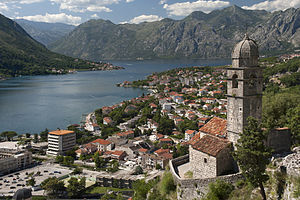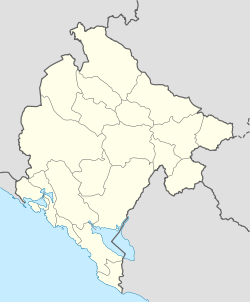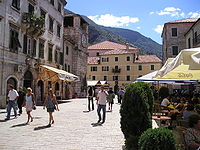- Kotor
-
For the Star Wars franchise, see Star Wars: Knights of the Old Republic (series)."Cattaro" redirects here. For the HAPAG steamship, see SS Cattaro.
Kotor
(Котор - Cattaro)
Flag
Coat of armsCoordinates: 42°25′48″N 18°46′12″E / 42.43°N 18.77°ECoordinates: 42°25′48″N 18°46′12″E / 42.43°N 18.77°E Country  Montenegro
MontenegroFounded 5th century BC Settlements 56 Government – Mayor Marija Ćatović (DPS) Area – Municipality 335 km2 (129.3 sq mi) Population (2003 census) – Total 5,341 – Density 68/km2 (176.1/sq mi) – Municipality 22,947 Time zone CET (UTC+1) – Summer (DST) CEST (UTC+2) Postal code 85330 Area code +382 32 ISO 3166-2 code ME-10 Car Plates KO Website www.opstinakotor.com Kotor (Montenegrin: Котор / Kotor, pronounced [kɔ̌tɔr] or [kɔ̂tɔr]; Italian: Càttaro; Latin: Acruvium; Ancient Greek: Ἀσκρήβιον, Askrebion') is a coastal city in Montenegro. It is located in a secluded part of the Gulf of Kotor. The city has a population of 13,510 and is the administrative center of the municipality.
The old Mediterranean port of Kotor is surrounded by an impressive city wall built by the Republic of Venice and Venetian influence remains predominant in the city's architecture. The Bay of Kotor (Boka Kotorska; Bocche di Cattaro), one of the most indented parts of the Adriatic Sea, is sometimes called the southern-most fjord in Europe (though it is actually a submerged river canyon). Together with the nearly overhanging limestone cliffs of Orjen and Lovćen, Kotor and its surrounding area form an impressive and picturesque Mediterranean landscape.
In recent years, Kotor has seen a steady increase in tourists, attracted by both the natural beauty of the Gulf of Kotor and the old town of Kotor itself.
Kotor is part of the World Heritage Site dubbed the Natural and Culturo-Historical Region of Kotor.
Contents
History
Kotor, first mentioned in 168 BC, was settled during Ancient Roman times, when it was known as Acruvium, Ascrivium, or Ascruvium and was part of the Roman province of Dalmatia.[1]
Kotor (then called "Cattaro") has been fortified since the early Middle Ages, when Emperor Justinian built a fortress above Acruvium in 535, after expelling the Ostrogoths; a second town probably grew up on the heights round it, for Constantine Porphyrogenitus, in the 10th century, alludes to Lower Kotor. The city was plundered by the Saracens in 840. Cattaro was one of the more influential Dalmatian City-states of romanized Illirians throughout the Middle Ages period. Until the 11th century the Dalmatian language was spoken in Cattaro.
In 1002, the city suffered damage under occupation of the First Bulgarian Empire, and in the following year it was ceded to Serbia by the Bulgarian Tsar Samuel. However, the local population resisted the pact and, taking advantage of its alliance with the Republic of Ragusa, only submitted in 1184, while maintaining its republican institutions and its right to conclude treaties and engage in war. It was already an episcopal see, and, in the 13th century, Dominican and Franciscan monasteries were established to check the spread of Bogomilism.
In the 14th century, commerce in Cattaro (as the city was called until 1918) competed with that of the nearby Republic of Ragusa and of the Republic of Venice. The city was part of the Venetian Albania province of the Venetian Republic from 1420 to 1797, except for periods of Ottoman rule in 1538–1571 and 1657-1699. Four centuries of Venetian domination have given the city the typical Venetian architecture, that contributed to make Kotor a UNESCO world heritage site.[2] In those centuries Renaissance-related literature enjoyed a huge develpment in Venetian Cattaro: the most famous writers were Bernardo Pima, Nicola Chierlo, Luca Bisanti, Alberto de Gliricis, Domenico and Vincenzo Burchia, Vincenzo Ceci, Antonio Zambella and Francesco Morandi.
While under Venetian rule, Cattaro was besieged by the Ottoman Empire in 1538 and 1657, endured the plague in 1572, and was nearly destroyed by earthquakes in 1563 and 1667. After the Treaty of Campo Formio in 1797, it passed to the Habsburg Monarchy. However, in 1805, it was assigned to the French Empire's client state, the Napoleonic Kingdom of Italy by the Treaty of Pressburg, although in fact held by a Russian squadron under Dmitry Senyavin. After the Russians retreated, Cattaro was united in 1806 with this Kingdom of Italy and then in 1810 with the French Empire's Illyrian Provinces. Kotor was captured by the British attack on the Bay led by Commodore John Harper in the brig sloop Austrian Empire by the Congress of Vienna.
In World War I, Kotor was one of three main bases of the Austro-Hungarian Navy and homeport to the Austrian Fifth Fleet, consisting of pre-dreadnought battleships and light cruisers. The area was the site of some of the fiercest battles between local Montenegrin Slavs, and Austria-Hungary. After 1918, the city (called Càttaro until then) became a part of Yugoslavia and officially became known as Kotor.
Between 1941 and 1943 Italy annexed the area of Kotor (with the original venetian name "Bocche di Cattaro") to the Italian "Governorship of Dalmatia" and created a new Italian Province: the Provincia di Cattaro, with 1075 km² and 128,000 population [3]
But after 1945 it became a part of the then Socialist Republic of Montenegro within Yugoslavia's second incarnation.
In 1979 (April 15) a major earthquake hit the Montenegrin coastal area. There were approximately 100 casualties. Half of Kotor's Old Town was destroyed and St. Tryphon's Cathedral was partly damaged.
Up until the beginning of the 20th century, Croatian Catholics constituted the majority around the Gulf of Kotor.
Kotor is still the seat of the Croatian Catholic Bishopric of Kotor, which covers the entire gulf.
Main sights
Cathedral of Saint Tryphon (Sv. Tripun).
Kotor has one of the best preserved medieval old towns in the Adriatic and is a UNESCO world heritage site.[2] It is home to numerous sights, such as the Cathedral of Saint Tryphon in the old town (built in 1166), and the ancient walls which stretch for 4.5 km directly above the city. Sveti Đorđe and Gospa od Škrpijela islets off the coast of Perast are also among the more popular destinations in the vicinity of Kotor.
Culture
Kotor hosts several summer events, such as the Summer Carnival or Bokeljska Noć.
Together with Budva, the city hosted the Federation of European Carnival Cities (FECC) World Carnival City Congress in May 2009.
Population
Kotor, part of the Natural and Culturo-Historical Region of Kotor * UNESCO World Heritage Site
Country Montenegro Type Cultural Criteria i, ii, iii, iv Reference 125 Region ** Europe and North America Inscription history Inscription 1979 (3rd Session) Extensions 1979-2003 * Name as inscribed on World Heritage List
** Region as classified by UNESCOKotor is the administrative centre of Kotor municipality, which includes the towns of Dobrota, Risan and Perast, as well as many small hamlets around the Bay of Kotor. In the mid 1800s the city had a mixed population of 1/3 Serbians, 1/3 Croats and 1/3 Italians. Since then the Italians have nearly disappeared[4], and now tha majority is made by "Montenegrins".
The municipality actually has a population of 22,947 (2003 census).[5] The town of Kotor itself has 5,341 inhabitants, but Kotor and Dobrota are practically one town, with a combined population of 13,176.[5]
Population of Kotor (Including Dobrota):
- March 3, 1981 - 10,780
- March 3, 1991 - 12,903
- November 1, 2003–13,176
Ethnic groups (1991 census):
- Montenegrins (55.24%)
- Serbs (14.07%)
- Croats (7.23%)
Ethnic groups (2003 census) - 22,947:
- Montenegrins - 10,741 (46.81%)
- Serbs - 7,094 (30.91%)
- Croats - 1,762 (7.68%)
- Yugoslavs - 168 (0.73%)
- Muslims - 106 (0.46%)
- Albanians - 76 (0.33%)
- Macedonians - 49 (0.21%)
- Romas - 48 (0.21%)
- Russians - 39 (0.17%)
- Slovenes - 35 (0.15%)
- Italians - 32 (0.14%)
- Hungarians - 32 (0.14%)
- Egyptians - 20 (0.09%)
- Bosniaks - 16 (0.07%)
- Germans - 14 (0.06%)
- others - 133 (0.58%)
- undeclared/undefined - 2,165 (9.43%)
- regionally affiliated - 202 (0.88%)
- no data - 215 (0.94)
According to documents from 1900, Kotor had 7,617 Catholics, and 7,207 Orthodox Christians.
Kotor is still the seat of the Catholic Bishopric of Kotor, which covers the entire gulf.
The 2003 census listed 22,947 citizens, of whom 78% were Orthodox Christians, 13% were listed as Roman Catholic.
Transport
Kotor is connected to the Adriatic Motorway and the rest of the coast and inland Montenegro by Vrmac Tunnel. Inland is reachable by detouring from Adriatic motorway at Budva or Sutomore (through Sozina tunnel). There is also a historic road connecting Kotor with Cetinje, which offers spectacular views of Kotor bay.
Tivat Airport is 5 kilometres (3.1 mi) away, and there are regular flights to Belgrade, Moscow and Paris and dozens of charter planes land daily on Tivat airport during the summer season.
Podgorica Airport is 65 kilometres (40 mi) away, and it has regular flights to major European destinations throughout the year.
People
 Serbian orthodox church of St Nicolas
Serbian orthodox church of St Nicolas
- Tomislav Crnković, Croatian footballer
- Stevan Faddy, Montenegrin Singer
- Zoran Gopčević, Montenegrin waterpolo player
- Vasko Lipovac, Croatian painter
- Ratimir Martinović, Montenegrin pianist
- Danilo Saveljić, Slovenian footballer
- Vlaho Orlić, Montenegrin waterpolo coach
- Andrija Paltašić, painter
- Nina Petković, Montenegrin singer and television personality
- Viktor Vida, Croatian write
- Boško Vuksanović, Montenegrin waterpolo coach
Twin towns
References
- ^ Jackson, Hamilton (2010). The Shores of the Adriatic (Illustrated Edition). Echo Library. p. 269. ISBN 9781406867619. http://books.google.com/books?id=ZyOYDrSkX80C&pg=PA287. Retrieved 21 February 2011.
- ^ a b "Natural and Culturo-Historical Region of Kotor". Unesco World Heritage Convention. http://whc.unesco.org/en/list/125. Retrieved 2010-12-08.
- ^ Rodogno, Davide (2003). Il nuovo ordine mediterraneo. Turin: Bollati Boringhieri.
- ^ "Comunita italiana del Montenegro" in 2010
- ^ a b "Document Nacionalna ili etnicka pripadnost – Podaci po naseljima i opstinama (2003 population census)". Statistical Office of Montenegro. 2003. pp. 48–49. http://www.monstat.org/userfiles/file/popis03/Popis01a.zip. Retrieved 2010-12-10.
External links
- Official website
- UNESCO: Natural and Culturo-Historical Region of Kotor
- Kotor City Guide - Hotels - Accommodation Rent a Car
- Boka Kotorska Photo Gallery
- Tourist Presentation of Kotor
- Foundation for Culture and Tradition of Boka Kotorska "Project Rastko-Boka" in Serbian
- Old Town Map (1944px × 2592px 851.58 Kb JPG)
- Foundation for Culture and Tradition of Boka Kotorska "Project Rastko-Boka" in Serbian
- Kotor on the photographs of Stevan Kordić
Categories:- Populated places in Montenegro
- Municipalities of Montenegro
- Kotor
- Territories of the Republic of Venice
Wikimedia Foundation. 2010.







